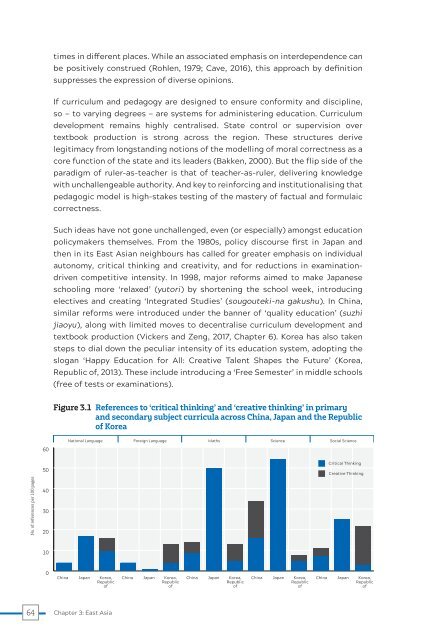Rethinking Schooling for the 21st Century
UNESCO MGIEP officially launched 'Rethinking Schooling for the 21st Century: The State of Education, Peace and Sustainable Development and Global Citizenship' in 2017 at the UNESCO General Conference. This study analyses how far the ideals of SDG 4.7 are embodied in policies and curricula across 22 Asian countries and establishes benchmarks against which future progress can be assessed. It also argues forcefully that we must redefine the purposes of schooling, addressing the fundamental challenges to efforts to promote peace, sustainability and global citizenship through education.
UNESCO MGIEP officially launched 'Rethinking Schooling for the 21st Century: The State of Education, Peace and Sustainable Development and Global Citizenship' in 2017 at the UNESCO General Conference. This study analyses how far the ideals of SDG 4.7 are embodied in policies and curricula across 22 Asian countries and establishes benchmarks against which future progress can be assessed. It also argues forcefully that we must redefine the purposes of schooling, addressing the fundamental challenges to efforts to promote peace, sustainability and global citizenship through education.
You also want an ePaper? Increase the reach of your titles
YUMPU automatically turns print PDFs into web optimized ePapers that Google loves.
times in different places. While an associated emphasis on interdependence can<br />
be positively construed (Rohlen, 1979; Cave, 2016), this approach by definition<br />
suppresses <strong>the</strong> expression of diverse opinions.<br />
If curriculum and pedagogy are designed to ensure con<strong>for</strong>mity and discipline,<br />
so — to varying degrees — are systems <strong>for</strong> administering education. Curriculum<br />
development remains highly centralised. State control or supervision over<br />
textbook production is strong across <strong>the</strong> region. These structures derive<br />
legitimacy from longstanding notions of <strong>the</strong> modelling of moral correctness as a<br />
core function of <strong>the</strong> state and its leaders (Bakken, 2000). But <strong>the</strong> flip side of <strong>the</strong><br />
paradigm of ruler-as-teacher is that of teacher-as-ruler, delivering knowledge<br />
with unchallengeable authority. And key to rein<strong>for</strong>cing and institutionalising that<br />
pedagogic model is high-stakes testing of <strong>the</strong> mastery of factual and <strong>for</strong>mulaic<br />
correctness.<br />
Such ideas have not gone unchallenged, even (or especially) amongst education<br />
policymakers <strong>the</strong>mselves. From <strong>the</strong> 1980s, policy discourse first in Japan and<br />
<strong>the</strong>n in its East Asian neighbours has called <strong>for</strong> greater emphasis on individual<br />
autonomy, critical thinking and creativity, and <strong>for</strong> reductions in examinationdriven<br />
competitive intensity. In 1998, major re<strong>for</strong>ms aimed to make Japanese<br />
schooling more ‘relaxed’ (yutori) by shortening <strong>the</strong> school week, introducing<br />
electives and creating ‘Integrated Studies’ (sougouteki-na gakushu). In China,<br />
similar re<strong>for</strong>ms were introduced under <strong>the</strong> banner of ‘quality education’ (suzhi<br />
jiaoyu), along with limited moves to decentralise curriculum development and<br />
textbook production (Vickers and Zeng, 2017, Chapter 6). Korea has also taken<br />
steps to dial down <strong>the</strong> peculiar intensity of its education system, adopting <strong>the</strong><br />
slogan ‘Happy Education <strong>for</strong> All: Creative Talent Shapes <strong>the</strong> Future’ (Korea,<br />
Republic of, 2013). These include introducing a ‘Free Semester’ in middle schools<br />
(free of tests or examinations).<br />
Figure 3.1 References to ‘critical thinking’ and ‘creative thinking’ in primary<br />
and secondary subject curricula across China, Japan and <strong>the</strong> Republic<br />
of Korea<br />
60<br />
National Language Foreign Language Maths<br />
Science Social Science<br />
No. of references per 100 pages<br />
50<br />
40<br />
30<br />
20<br />
Critical Thinking<br />
Creative Thinking<br />
10<br />
0<br />
China<br />
Japan<br />
Korea,<br />
Republic<br />
of<br />
China Japan Korea,<br />
Republic<br />
of<br />
China Japan Korea,<br />
Republic<br />
of<br />
China Japan Korea,<br />
Republic<br />
of<br />
China Japan Korea,<br />
Republic<br />
of<br />
64<br />
Chapter 3: East Asia

















